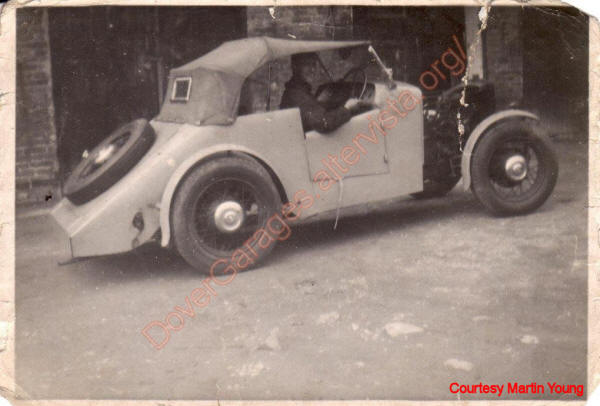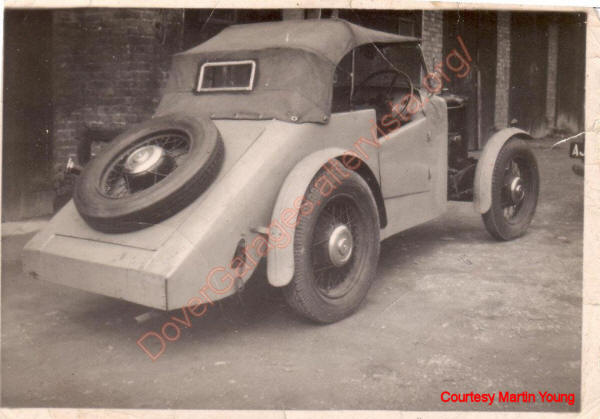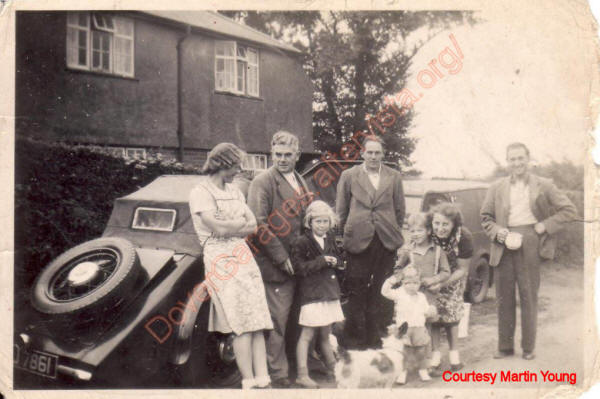Dover Kent UK
History of Dover Garages
The story of the creation of a 1950 hand built Hillman Minx based ‘Sport Special’.
Some seven years ago, when living in my home county of Kent, I attended an evening lecture given by John Nash on how he went about designing and building his award winning ‘John Nash Special’, and it got me thinking about my Dad’s unsung achievement of hand building his own motorcar nearly 60 years ago. I took my son Thomas and my friend Colin Underdown along who has also built a ‘Special’, but John and Colin have built their cars out of enthusiasm, but my father built his out of necessity. A true forefather of the kit car and specials fraternity, and so I decided to write this tribute to him at that time before it was too late for him to read. It was first published in the Kent Kit Car Club magazine ‘The Grin Factor’ August 2010.
The story starts with my father Shamous Henry Young, who passed away in 2013 in his 95th year. As an infant, an operation to remove an abscess from beneath his right kneecap went horribly wrong, leaving him with a leg he was unable to bend, which led to many years confined in St Thomas’ Hospital without proper schooling. Despite his lack of education and his disability, it did not deter Dad from gleaning know-how and experience in various skills from the motor trade in 1930’s North London and Essex, in some instances peddling with his good leg on a fixed wheel bicycle many miles to and from work. Classed as unfit for military service, during the early part of WWII he worked as a fitter/welder for James Collis & Co. Grays Inn Road, making torpedo and bomb trolleys. It was during this time that he met and eventually married my Mum in 1941. The ‘Blitz’, and further bombing raids were to be the turning point in the newly wed’s fortunes. Fed up with being bombed out of various homes, in 1943 Dad volunteered for essential Ministry of Defence work in Dover, and Mum had also heard from friends that good housing was available there. They found a small terraced house in Buckland, and Dad started work as a fitter/ vehicle mechanic in a factory requisitioned for war work opposite The Railway Bell at Kearsney, which is now the garage of D.P. Lead & Sons. After the end of hostilities Dad worked as a garage mechanic at Spot Garage, London Road, Buckland; owned by one Mr. Spain. Not having his own means of transport to visit relatives in far away London, first Dad scratch-built a motorcycle and sidecar combination. The motorbike frame was bent, so Dad used jacks held horizontally between the back bedroom walls and the frame to straighten it – nearly pushing one wall out in the process! It wasn’t the best of options as the foot controls had to be modified, and much to Mum’s horror, Dad’s right trouser leg used to regularly catch fire from rubbing on the hot exhaust pipe. The combo was used for a few years until Mum fell pregnant with me, and so Dad’s thoughts turned to getting a car. Money was still tight and with a new family member on the way, buying a new or second-hand car was out of the question, but he had skills, and so during the nine months I was being hatched, Dad set to work on two projects, the first to stop drinking and smoking and save the money for his second - to build his own motorcar! The chassis, axles and wire spoked wheels of a 1930s Hillman Minx were given to Dad by a friendly local tyre salesman. Being ‘a bit of a lad’ Dad wanted a sporty looking car, and so based the outline on the MG sports cars of the time! He used no drawings or sketches, the design was in his head, and he measured, cut and made templates to suit the chassis and his idea. Other scrap car parts he bought mainly from Horace Coppin’s scrap yard that used to be in Cherrytree Avenue, or other yards at Tilmanstone and Lydden. He overhauled and rebuilt a replacement 10hp engine to run on both petrol and paraffin, and formed all the sheet metal body panels, floor pans and bonnet by hand using a boot hammer and wood forming blocks. The panel seams he hid by using lead solder. No fibreglass or modern fillers were available then. He even wired up all the electrics, and made the retractable tubular framing and the canvas hood himself, stitching it on a borrowed industrial sewing machine! The doors had no windows fitted, but in case of rain, Dad made Perspex screens which attached onto clips fitted on both the hood and doors. Unlike today’s cars there was no basic heating! Cellulous paint was used, and the car finished with the bodywork and mudguards painted dark blue, and the spoked wheels painted bright red, with the spare wheel mounted on the sloping boot lid. It looked a right head turner! To get it licensed and insured, Dad had to prove that the car was roadworthy and arranged with the Legal & General Insurance Co. of London to send a Vehicle Inspector to Dover and check the car. Having had the facilities of the garage at hand, the car passed muster! The car was registered at Maidstone as a new vehicle with the registration number LJ 7861. Dad put the finishing touches to the car a few days before I was born in February 1951. Then, as a surprise thank you present, he presented the completed car to my Mum on the morning of the day I was born. Project Two was successfully complete!
Project One? Also successfully completed! And to this day, he has never once seriously considered taking up drinking or smoking again! Wherever Mum, Dad and I went in the car; people would ask what it was and how it had been made. Even police officers and AA/RAC patrolmen would stop Dad to curiously crawl all over (and under) it in amazement! The two photos below show the partially complete car on test behind Spot Garage,


This photo below show sthe car (with a young me at the wheel) outside the hop pickers huts in the hop gardens of Wingham.

The group photo is of us visiting family friends who lived in Peatling Parva, Leicestershire, a journey of about 170 miles, which in the early 1950s took well over 6 hours!

There were no Motorways then, so Dad must have driven us up and down the A5, and to my surprise; less than a quarter of a mile from where I now live.
We were one of the first families in our road, or indeed Dover, to own a car, and travelled miles across the country before Dad sold it in 1958, two years after my brother Timothy was born. The cramped back seat was unfortunately getting too small for my growing brother and me. I vividly remember Dad taking me with him when he sold the car to a young couple who lived near Buckland C of E Primary School. And then after the deal was struck: seeing it being driven off by its new owner past Cherrytree Avenue towards Dover High Street. It’s funny, but I cannot recall ever seeing it again. Dad continued working at Spot Garage for about another five years after I was born, and then worked for Southern Autos in Dover, where his new boss, (he told me with a giggle) was a Mr. Ken Dodds! From there he quickly found an even better job with The Dover Harbour Board as a Maintenance Fitter working on all the harbour and dockside equipment, including the steam tugs, Lady Duncannon and Lady Brassey during their annual refits: never once making an issue of his leg. In 1967 we moved to East Studdal where Dad finally built his own large workshop in which he helped build one of the first Beach Buggies seen in Kent. Local farmer’s son Hugh Densham had bought a Beach Buggy Kit and a second hand VW Beetle as the donor car, which had to be shortened to fit the new fibreglass body shell. Hugh asked Dad for his help, and so Dad cut out the required section from the floor-pan and oxy-acetylene gas welded the shortened halves together, before the refurbished engine, the body shell and roll-bar etc, could all be fitted. Another first! Then for many years he spent his spare time maintaining the cars of family and friends, with the help of either my brother or myself. Dad retired from The Dover Harbour Board in 1983 as one of the Chief Engineers of the diesel tugs, Diligent and Dominant. During his retirement years he kept himself busy refurbishing many items of garden machinery, and was still driving at the age of 89 when frailty finally caught up with him. We, as a family, often speak of the car, and Dad had always proudly carried the original photos of it in his wallet, that over the years had been eagerly shown to the many listeners of his stories, including his three grandchildren. I don’t think he has ever had any photos of Tim and me! Strange that? Must be a bloke thing! Dad said, it never occurred to him to take more photos of the car when it was under construction; we are so lucky that the few photos shown here have survived for so long. What of the car? I have been in touch with the DVLA to see if the records of the car still exist, but have received a letter telling me that because the car was registered so early it does not appear on the DVLA database. So! Does it still exist in some dusty barn, or did it go to the great scrap yard in the sky? It would be nice to know.
I hope you have enjoyed reading this story. To coin a phrase: ’Necessity is the mother of Invention’, and to successfully build your own car is a true enterprising experience, one to be justly proud of!
Martin Young. MSc. (Eng) CEng. CMIET MIET
Dunstable.
24 Aug 2017
If you see this car or the registration number LJ7861 anywhere please take a photo and send it to dovergarages@gmail.com